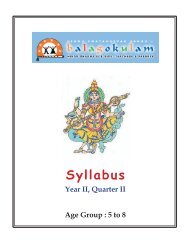Bauddhik Plan for Age Group 9-12 for the second ... - Balagokulam
Bauddhik Plan for Age Group 9-12 for the second ... - Balagokulam
Bauddhik Plan for Age Group 9-12 for the second ... - Balagokulam
You also want an ePaper? Increase the reach of your titles
YUMPU automatically turns print PDFs into web optimized ePapers that Google loves.
DharmaSeptemberon plants and trees. They give us <strong>the</strong> vital factors that makes life possible onearth: food, oxygen, clothing, shelter, medicines etc.Hence, in Bharat, we are taught to regard trees and plants as sacred.Hindu scriptures tell us to plant ten trees if, <strong>for</strong> any reason, we have to cutone. We are advised to use parts of trees and plants only as much as isneeded <strong>for</strong> food, fuel, shelter etc. we are also urged to apologize to a plant ortree be<strong>for</strong>e cutting it.Certain trees and plants like tulasi, peepal etc. which have tremendousbeneficial qualities, are worshipped till today. It is believed that divine beingsmanifest as trees and plants, and many people worship <strong>the</strong>m to fulfill <strong>the</strong>irdesires or to please <strong>the</strong> Lord.Why do we say shaanti thrice?Shaanti, meaning “peace”, is a natural state of being. Disturbances arecreated ei<strong>the</strong>r by us or o<strong>the</strong>rs. For example, peace already exists in a placeuntil someone makes noise. There<strong>for</strong>e, peace underlies all our agitations.When agitations end, peace is naturally experienced since it was already<strong>the</strong>re. Where <strong>the</strong>re is peace, <strong>the</strong>re is happiness. There<strong>for</strong>e, every one withoutexception desires peace in his/her life.However, peace within or without seems very hard to attain because it iscovered by our own agitations. A rare few manage to remain peaceful withineven in <strong>the</strong> midst of external agitation and troubles. To invoke peace, wechant prayers. By chanting prayers, troubles end and peace is experiencedinternally, irrespective of <strong>the</strong> external disturbances. All such prayers end bychanting shaanti thrice.It is believed that trivaram satyam - that which is said thrice comes true.For emphasising a point we repeat a thing thrice. In <strong>the</strong> court of law also, onewho takes <strong>the</strong> witness stands says, “I shall speak <strong>the</strong> truth, <strong>the</strong> whole truthand nothing but <strong>the</strong> truth”.The popular notion of peace today is ‘absence of war’. But Hindus thinkof peace at three levels. We chant shaanti thrice to emphasize our intensedesire <strong>for</strong> peace. All obstacles, problems and sorrows originate from threesources.Aadhidaivika: The unseen divine <strong>for</strong>ces over which we have little or nocontrol like earthquakes, floods, volcanic eruptions etc.Hindu Swayamsevak Sangh (HSS)43
















